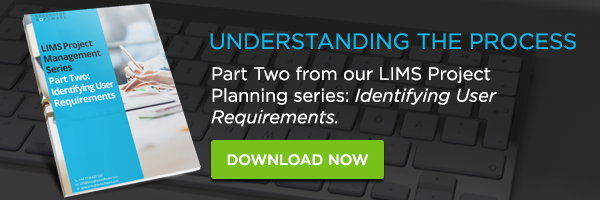
Validating LIMS is a fundamental requirement for GMP compliance. Where LIMS is used to store and process GMP data, it is imperative that the system accurately and reliably performs as expected. This is where the validation and implementation project play an important part in the lifecycle of a LIMS. It should be focused on aspects related to patient safety, product quality and data integrity. In this article, we highlight some of the key features that regulators are looking for in a LIMS validation plan.
Roles and Responsibilities
Defining the roles and responsibilities is one of the first tasks within any LIMS implementation project. Set the foundations for a successful implementation by providing clarity on what roles are required, what tasks the role must carry out, and who is taking ownership of these roles.
The main role is the Project Manager. This person has overall responsibility for controlling project activities, resources and cost. They monitor progress and help team members to address and resolve any issues that arise. They will report to the Project Sponsor and Senior Management on the progress against objectives, and they will also liaise with Quality to ensure compliance is maintained throughout the project.
The Quality Unit ensures compliance with appropriate regulatory requirements and company policies. They provide support in reviewing and approving validation documentation and project deliverables, and they also have the responsibility for approving the release of the system for operational use.
Depending on the scale of the project, the size of the system, and the resource available, there are many other roles that could also be defined to implement a LIMS. Examples of additional roles are: Business Lead, Developers, Test Manager, Configuration Manager, Incident Manager, Change Manager, Document Controller, and Subject Matter Experts.
Acceptance Criteria
How do you know when the project is complete? By defining acceptance criteria, the team will have a shared understanding of their project goals. Acceptance criteria can be defined for different stages of the project. This allows you to address any issues and implement corrective action before continuing to the next stage of the project, ultimately circumventing the effect of compounding issues.
One example for defining acceptance criteria is through the traceability of User Requirements. At the start of the project, you may have defined what exactly you need from your LIMS. This includes system functionality, system administration and on-going technical support. For each requirement, you may have also defined which are mandatory or desirable. Therefore, you may document that all mandatory requirements must be successfully met before the system is released for operational use.
For laboratories who may take a risk-based approach, you may look to define your acceptance criteria based on your risk assessment. This means you may accept that not all mandatory requirements are met through system functionality, and that you are happy to implement procedural controls to address any potential risks.
Either approach for defining acceptance criteria is acceptable for your LIMS project, and a great project document which ties it altogether is a Requirements Traceability Matrix.
Maintaining Compliance
Validating LIMS is about ensuring the system implemented is “fit for purpose”, and it consistently meets requirements. What about after the project is complete? Documenting how you plan to maintain the system’s compliance, during operational use, is also an important part of the implementation project.
It is inevitable that over the course of using LIMS, your needs will change. Whether change is brought on by business growth, new technology, or change in regulations, your requirements of the system is bound to change over time. You may find that you want to introduce additional automation to your laboratory practices through LIMS, and having a documented change control process will help you address your change in needs. It is acceptable to amend your existing change control process to accommodate changes to computer systems, or you may wish to create a separate process altogether. Either way, ensure that you have the resource (competent and trained) to accommodate your chosen practice.
Another way to ensure compliance is maintained during operational use is to review your Standard Operating Procedures. Before you implemented LIMS, you will have a documented set of procedures used within your laboratory. It is best practice to review these procedures and ensure that they are updated accordingly to reflect your new way of working once LIMS is implemented. This should also include any training requirements for new and existing analysts.






